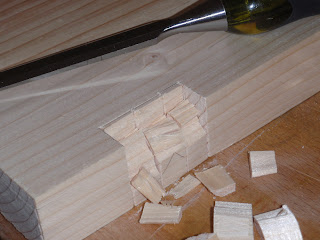This is the hardest part of this project, at least in my opinion - Cutting the legs accurately to produce a ten degree splay to the legs. The first thing was to group the eight legs into two lots of four for each stool matching the grain of each set and deciding which would be the visible outward face of each leg, hiding knots and other nasties on the inner faces.
Setting my bevel gauge to 100 degrees to give me my 10 degree splay angle (90 + 10 = 100), I began marking out the legs. unfortunately, I got so engrossed with concentration I didn't take any pictures to fully describe the process.
In addition, I didn't think to limit my marking with the knife as I squared the lines around the legs, resulting in unnecessary marks on the show side of the legs - doh! I will plane and sand them away before assembly.
Luckily I noticed the error of my ways before starting the second set of legs and limited my marking to only those lines to be cut.
With the marking out complete and the waste clearly marked with Xs, I used a chisel to pare out the cross grain lines to make a groove for the saw. Placing the piece offset in the vice, I used the bevel gauge to make the cut vertical. My sawing accuracy is considerably better when cutting straight down vertically, probably due to gravity helping to hold the saw straight.
I started with the shoulder as it's a short cut and across the grain, so a nice and easy warm up for my sawing muscles.
Before cutting the rip cuts down what I guess would be called the 'cheek', I found it easier to use my dovetail saw placed in the knife lines to perform a 'stopped' cut across the corners of the cut on each side before placing the piece in the vice for cutting squarely down.
Despite having done this identical marking out and cutting process a few times now, for both my original Rustic Stool and my Traditional Saw bench, it still takes me a surprisingly long time to carry out this simple task. Eventually, I had four legs all cut and pared, ready for use.
Now for the other four legs - Rinse and repeat as they say ...
The next step is to mark out the four cut-outs in each seat top to accept the legs. Simple marking out using a marking gauge (for the depth of cut) and a square. I set each leg 'socket' back from the seat end the same thickness as the leg.
I made four cuts to each 'socket' to make chiselling out easier with less risk of break out. Using a small chisel to begin with, I removed 80% of the wood from each side of the cut out.
Finally using my larger chisel placed directly in the knife line to finish the cut.
After a little paring with the chisel and size adjustment with a file, I had two standing stools.
Still a long way from being finished but at least they resemble something close to stools now.
The next job will be the bracing in pt3....












3 comments:
Hi.
Well, i had to comment... My name is Richard and I'm from Portugal. I found your Blog a while ago and i immediately related to you because your work bench is exactly like mine... and you had exactly the same problems with it.
Then, reading the blog, i found we like doing the same kind of things. And the problems we face are very similar. Unfortunately, i don´t have the resources to buy good tools, so i reuse a lot, try to build my own, and try to find old ones from family and friends (with little success). I also read a lot, and as you, old books are my main source of information. They are free and can be downloaded and calmly studied.
I'm building now my first saw horse, following the instructions of Christopher Schwarz. I had to stop because i don't have a rebate plane, so I'm building one too.
Last week my wife offered me a small hatchet, and surprise... i also find you have information on axes...
Well, you're a sailor, and i was a pilot, so there are differences ;-)
Thanks a lot for your Blog. It is an inspiration for me, because i see another woodworker who finds the same problems and challenges i find and continues. Hope you continue your great work and your great Blog.
Thanks for everything.
Hi there Ricardo - Very nice to meet you. I think most beginner wood workers go through a similar learning process with the same difficulties and frustrations. I think it helps to know you are not alone in this difficult beginning stage, so I hope my Blog is useful to you in some way. I find I learn lots from other peoples Blogs. Good luck with the Saw Bench and thanks for reading.
Download 16,000 Woodworking Plans & Projects .
“woodworking pro weebly” (Google it)
This woodworking book contains a great deal of details about wood working. The book also shows several designs and explanations on the materials useful for different woodworking processes and the directions on completing different processes properly. In other words, I`m happy using this book, specially in the procedure of understading about wood working.
Post a Comment